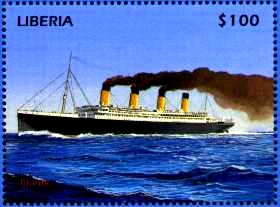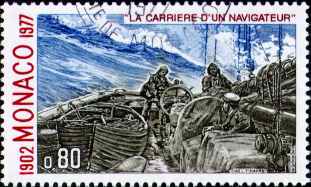|

|
Maritime Topics On Stamps:
Windforce Scale !
|
Windforce: Beaufort scale,
Description - sea surface: Peterson.
Wind force 0 :
Wind speed:
0,0001 kn, 0 - 0,2 m/s, 0 - 1 km/h
Notation: Calm
Description: mirror like sea, only swell
|

|

|
Wind force 1 :
Wind speed:
1...3 kn, 0,3 - 1,5 m/s, 1 - 5 km/h
Notation: Light Air
Description: Ripples with the appearance of scales
|
Wind force 2 :
Wind speed:
4...6 kn, 1,6 - 3,3 m/s, 6 - 11 km/h
Notation: Light Breeze
Description: Small wavelets, crest of glassy appearance, not breaking
|

|

|
Wind force 3 :
Wind speed:
7...10 kn, 3,4 - 5,4 m/s, 12 - 19 km/h
Notation: Gentle Breeze
Description: Large wavelets, crests begin to break, scattered with whitecaps
|
Wind force 4 :
Wind speed:
11...15 kn, 5,5 - 7,9 m/s, 20 - 28 km/h
Notation: Moderate Breeze
Description: Small waves, becoming longer, numerous whitecaps
|

|

|
Wind force 5 :
Wind speed:
16...21 kn, 8,0 - 10,7 m/s, 29 - 38 km/h
Notation: Fresh Breeze
Description: Long waves with many whitecaps, sometimes spray
|
Wind force 6 :
Wind speed:
22...27 kn, 10,8 - 13,8 m/s, 39 - 49 km/h
Notation: Strong Breeze
Description: Larger waves forming, whitecaps everywhere, more spray
|

|

|
Wind force 7 :
Wind speed:
28...33 kn, 13,9 - 17,1 m/s, 50 - 61 km/h
Notation: Near Gale
Description: Sea heaps up, white foam from breaking waves begins to blow in streaks
|
Wind force 8 :
Wind speed:
34...40 kn, 17,2 - 20,7 m/s, 62 - 74 km/h
Notation: Fresh Gale
Description: Moderately high waves of greater length, edges of crests begin to break
into spindrift, foam is blown into wellmarked streaks
|

|

|
Wind force 9 :
Wind speed:
41...47 kn, 20,8 - 24,4 m/s, 75 - 88 km/h
Notation: Strong Gale
Description: High waves, seas begins to roll, dense streaks of foam, spray may reduce
visibility
|
Wind force 10 :
Wind speed:
48...55 kn, 24,5 - 28,4 m/s, 89 - 102 km/h
Notation: Whole Gale
Description: Very high waves with overhanging crests, sea takes white appearance as foam
is blown in very dense streaks, rolling is heavy and visibility is reduced
|

|

|
Wind force 11 :
Wind speed:
56...63 kn, 28,5 - 32,6 m/s, 103 - 117 km/h
Notation: Storm
Description: Exceptionally high waves, sea covered with white foam patches, visibility
still more reduced
|
Wind force 12 :
Wind speed:
>64 kn, >32,7 m/s, >117 km/h
Notation: Hurricane
Description: Air filled with foam, sea completely white with driving spray, visibility still more
reduced
|

|
|
At Wind force 12 the Beaufort scale ends. Strong tropical cyclones, hurricanes,
tornados and 'El Nino' made a new scale necessary. So the Saffir-Simpson scale by
categories was developped.
In 1949 also the Beaufortla was expanded by five hurricane levels :
Wind force 12 :
Wind speed : 118 - 133 km/h; instead of > 117
Wind force 13 :
Wind speed : 134 - 149 km/h
Wind force 14 :
Wind speed : 150 - 166 km/h
Wind force 15 :
Wind speed : 167 - 183 km/h
Wind force 16 :
Wind speed : 184 - 202 km/h
Wind force 17 :
Wind speed : > 202 km/h
|

|
| Saffir - Simpson Scale |
| Status |
Winds knots |
Winds mph |
Pressure |
Storm Surge |
| Depression |
<35 kn> |
<38 mph> |
------> |
----- |
| Tropical Storm |
35-63 kn |
38-73 mph |
------ |
----- |
| Category 1 |
64-82 kts |
74-95 mph |
966 mb> |
4 - 5 ft |
| Category 2 |
83-95 kts |
96-110 mph |
980-965 mb |
6 - 8 ft |
| Category 3 |
96-113 kts |
111-130 mph |
964-945 mb |
9 - 12 ft |
| Category 4 |
114-135 kts |
131-155 mph |
944-920 mb |
13 - 18 ft |
| Category 5 |
136 kts+ |
156 mph+ |
<920 mb> |
>18 ft |
|
This table was taken from the
'Hurricane Watch Net', http://www.hwn.org
|
Specially for Tornados the Fujita Scale was developed:
| Fujita Scale |
| F-Scale Number | Intensity Phrase | Wind Speed | Type of Damage Done |
|---|
| F0 | Gale tornado | 40-72 mph |
Some damage to chimneys; breaks branches off trees; pushes over shallow-rooted trees; damages sign boards. |
|---|
| F1 | Moderate tornado | 73-112 mph |
The lower limit is the beginning of hurricane wind speed; peels surface off roofs; mobile homes pushed off
foundations or overturned; moving autos pushed off the roads; attached garages may be destroyed. |
|---|
| F2 | Significant tornado | 113-157 mph |
Considerable damage. Roofs torn off frame houses; mobile homes demolished; boxcars pushed over; large trees snapped
or uprooted; light object missiles generated. |
|---|
| F3 | Severe tornado | 158-206 mph |
Roof and some walls torn off well constructed houses; trains overturned; most trees in fores uprooted |
|---|
| F4 | Devastating tornado | 207-260 mph |
Well-constructed houses leveled; structures with weak foundations blown off some distance; cars thrown and large
missiles generated. |
|---|
| F5 | Incredible tornado | 261-318 mph |
Strong frame houses lifted off foundations and carried considerable distances to disintegrate; automobile
sized missiles fly through the air in excess of 100 meters; trees debarked; steel re-inforced concrete structures
badly damaged. |
|---|
| F6 | Inconceivable tornado | 319-379 mph |
These winds are very unlikely. The small area of damage they might produce would probably not be recognizable
along with the mess produced by F4 and F5 wind that would surround the F6 winds. Missiles, such as cars and
refrigerators would do serious secondary damage that could not be directly identified as F6 damage. If this level is
ever achieved, evidence for it might only be found in some manner of ground swirl pattern, for it may never be
identifiable through engineering studies |
|---|
|
This table was taken from the
'The Fujita Scale', http://www.tornadoproject.com/fscale/fscale.htm
|
|